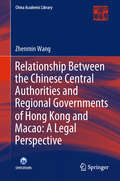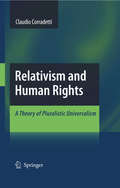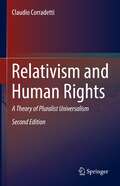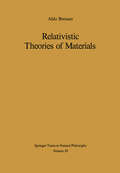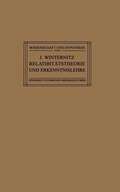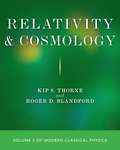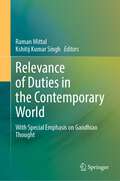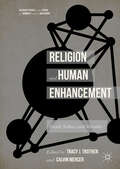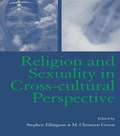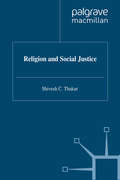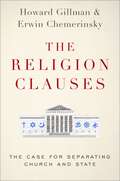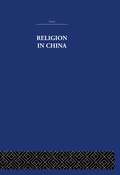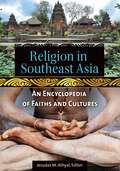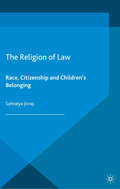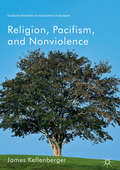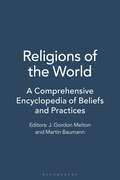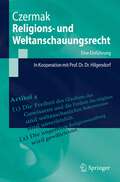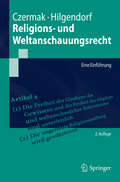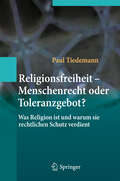- Table View
- List View
Relationship Between the Chinese Central Authorities and Regional Governments of Hong Kong and Macao: A Legal Perspective (China Academic Library)
by Zhenmin WangThis book discusses the basic theories and structures employed in handling the Central-SAR relationship under the “One Country, Two Systems” policy from the perspective of ruling by law. It also explores the fundamental principles and methods used in the division of powers between the central authorities and the SARs, and investigates the institutions responsible for handling the Central-SAR relationship and their practices. Further, it presents case studies since 1997 to help readers better understand the Central-SAR relationship. Lastly, the author raises some new questions for readers who want to further study this topic.
Relativism and Human Rights: A Theory of Pluralistic Universalism
by Claudio CorradettiWhen he nished writing, he raised his eyes and looked at me. From that day I have thought about Doktor Pannwitz many times and in many ways. I have asked myself how he really functioned as a man; how he lled his time, outside of the Polymerization and the Indo- Germanic conscience; above all when I was once more a free man, I wanted to meet him again, not from a spirit of revenge, but merely from a personal curiosity about the human soul. Because that look was not one between two men; and if I had known how completely to explain the nature of that look, which came as if across the glass window of an aquarium between two beings who live in different worlds, I would also have explained the essence of the great insanity of the third Germany. PRIMO LEVI [If this is a man, pp. 111–112, in, If this is a man and The truce, trans. S. Woolf, Abacus, London, 1987] If all propositions, even the contingent ones, are resolved into identical propositions, are they not all necessary? My answer is: certainly not. For even if it is certain that what is more perfect is what will exist, the less perfect is nevertheless still possible. In propositions of fact, existence is involved. LEIBNIZ [Samtlic ¨ he schriften und briefe vol VI pt 4 Deutsche Akademie der Wissenschaften, 1449A VI 4] We live in a rule-constrained world.
Relativism and Human Rights: A Theory of Pluralist Universalism
by Claudio CorradettiThis is an innovative contribution to the philosophy of human rights. Considering both legal and philosophical scholarship, the views here bear an importance on the legitimacy of international politics and international law. As a result of more than 10 years of research, this revised edition engages with current debates through the help of new sections. Pluralistic universalism considers that, while formal filtering criteria constitute unavoidable requirements for the production of potentially valid arguments, the exemplarity of judgmental activity, in its turn, provides a pluralistic and retrospective reinterpretation for the fixity of such criteria. While speech formal standards grounds the thinnest possible presuppositions we can make as humans, the discursive exemplarity of judgments defends a notion of validity which is both contextually dependent and "subjectively universal". According to this approach, human rights principles are embedded within our linguistic argumentative practice. It is precisely from the intersubjective and dialogical relation among speakers that we come to reflect upon those same conditions of validity of our arguments. Once translated into national and regional constitutional norms, the discursive validity of exemplar judgments postulates the philosophical necessity for an ideal of legal-constitutional pluralism, challenging all those attempts trying to frustrate both horizontal (state to state) and vertical (supra-national-state-social) on-going debates on human rights.On the first edition of this book: “Claudio Corradetti’s book is a thoughtful attempt to find an adequate theoretical foundation for human rights. Its approach is interdisciplinary in nature, drawing on issues in analytical philosophy as well as contemporary political theorists, and the result is a densely argued text aimed at scholars … .” (Andrew Lambert, Metapsychology Online Reviews, Vol. 14 (3), January, 2010)
Relativistic Theories of Materials (Springer Tracts in Natural Philosophy #29)
by A. BressanThe theory of relativity was created in 1905 to solve a problem concerning electromagnetic fields. That solution was reached by means of profound changes in fundamental concepts and ideas that considerably affected the whole of physics. Moreover, when Einstein took gravitation into account, he was forced to develop radical changes also in our space-time concepts (1916). Relativistic works on heat, thermodynamics, and elasticity appeared as early as 1911. However, general theories having a thermodynamic basis, including heat conduction and constitutive equations, did not appear in general relativity until about 1955 for fluids and appeared only after 1960 for elastic or more general finitely deformed materials. These theories dealt with materials with memory, and in this connection some relativistic versions of the principle of material indifference were considered. Even more recently, relativistic theories incorporating finite deformations for polarizable and magnetizable materials and those in which couple stresses are considered have been formulated. A broader description of the development of these relativistic topics is contained in § 13. The purpose of this book is to describe the foundations of the general relativistic theories that include constitutive equations, and to present some applications, mainly to elastic waves, of these theories. This tract is divided into two parts. In the first part only the Eulerian point of view is considered; basic equations of general relativity, other than constitutive equations, are stated in full generality (except for couple stresses which are considered in part 2). Part 1 also thoroughly covers fluids, including constitutive equations.
Relativitätstheorie und Erkenntnislehre: Eine Untersuchung über die Erkenntnistheoretischen Grundlagen der Einsteinschen Theorie und die Bedeutung Ihrer Ergebnisse für die Allgemeinen Probleme des Naturerkennens (Wissenschaft und Hypothese #23)
by Dr. Josef WinternitzDieser Buchtitel ist Teil des Digitalisierungsprojekts Springer Book Archives mit Publikationen, die seit den Anfängen des Verlags von 1842 erschienen sind. Der Verlag stellt mit diesem Archiv Quellen für die historische wie auch die disziplingeschichtliche Forschung zur Verfügung, die jeweils im historischen Kontext betrachtet werden müssen. Dieser Titel erschien in der Zeit vor 1945 und wird daher in seiner zeittypischen politisch-ideologischen Ausrichtung vom Verlag nicht beworben.
Relativity and Cosmology: Volume 5 of Modern Classical Physics
by Kip S. Thorne Roger D. BlandfordA groundbreaking textbook on twenty-first-century general relativity and cosmologyKip Thorne and Roger Blandford’s monumental Modern Classical Physics is now available in five stand-alone volumes that make ideal textbooks for individual graduate or advanced undergraduate courses on statistical physics; optics; elasticity and fluid dynamics; plasma physics; and relativity and cosmology. Each volume teaches the fundamental concepts, emphasizes modern, real-world applications, and gives students a physical and intuitive understanding of the subject.Relativity and Cosmology is an essential introduction to the subject, including remarkable recent advances. Written by award-winning physicists who have made fundamental contributions to the field and taught it for decades, the book differs from most others on the subject in important ways. It highlights recent transformations in our understanding of black holes, gravitational waves, and the cosmos; it emphasizes the physical interpretation of general relativity in terms of measurements made by observers; it explains the physics of the Riemann tensor in terms of tidal forces, differential frame dragging, and associated field lines; it presents an astrophysically oriented description of spinning black holes; it gives a detailed analysis of an incoming gravitational wave’s interaction with a detector such as LIGO; and it provides a comprehensive, in-depth account of the universe’s evolution, from its earliest moments to the present. While the book is designed to be used for a one-quarter or full-semester course, it goes deep enough to provide a foundation for understanding and participating in some areas of cutting-edge research.Includes many exercise problemsFeatures color figures, suggestions for further reading, extensive cross-references, and a detailed indexOptional “Track 2” sections make this an ideal book for a one-quarter or one-semester courseAn online illustration package is available to professorsThe five volumes, which are available individually as paperbacks and ebooks, are Statistical Physics; Optics; Elasticity and Fluid Dynamics; Plasma Physics; and Relativity and Cosmology.
Release Your Inner Lioness: Empowering Quotes from Kickass Women in Sport: Crush Your Goals, Celebrate Your Strength and Live Life to the Full
by Harriet DyerSupercharge your game and claim your victory with this powerful collection of uplifting words from kickass women in sportInside every woman is a lioness just waiting to break free. This feisty feline is independent, brave, strong and agile. She is ready to acknowledge and shout about her power. She wants to crush her goals. She believes she deserves to live her life courageously and to the full. All she needs is for you to open your heart and set her free.This small-but-mighty book is the perfect companion on your journey to attaining the unshakeable confidence of a lioness. Inside you’ll find empowering quotes from sporting legends all the way from Billie Jean King right up to Leah Williamson. Let these bold words from badass women inspire you to find your pride of supportive sisters, reach for your dreams, and celebrate every success along the way.Stay fierce and fearless – unleash your inner lioness and hear her roar!
Relevance of Duties in the Contemporary World: With Special Emphasis on Gandhian Thought
by Raman Mittal Kshitij Kumar SinghThis book reflects on the significance of duties in creating an egalitarian society by collating and contextualizing the relevant literature. It particularly focuses on an appreciation of Gandhi’s views on duty to showcase how they remain pertinent to create a cohesive, responsible and value-based society in the present right-dominated world. A viable solution to the current real world problems could be found in exploring the philosophy on duties and the book provides relevant literature in this regard. It undertakes jurisprudential analysis of duty in a rights-dominated world, identifying the gaps in realising the potential of duty to address the critical issues of the present times. It argues that enforcement of rights depends heavily on the observance of duties and proposes coherence in right-duty relationship. Gandhian thought on duty recognises duty as a precursor to rights and emphasises that the observance of duties guarantees the enforcement of rights. The relevance of duties and Gandhian thoughts on the same is not restricted to India but transcends borders with profound appeal. Gandhian thoughts have become even more relevant in the current times to examine the situation of COVID-19 pandemic, racial discrimination (BLM), environmental crises, digital divide, health care and medical care crises, refugee and migrant labour problems and it can offer promising solutions based on the nuances of social solidarity, self realisation of duties/responsibilities, local governance, compassion and humanity.
Religion and Human Enhancement: Death, Values, and Morality (Palgrave Studies in the Future of Humanity and its Successors)
by Tracy J. Trothen and Calvin MercerThis collection vigorously addresses the religious implications of extreme human enhancement technology. Topics covered include cutting edge themes, such as moral enhancement, common ground to both transhumanism and religion, the meaning of death, desire and transcendence, and virtue ethics. Radical enhancement programs, advocated by transhumanists, could arguably have a more profound impact than any other development in human history. Reflecting a range of opinion about the desirability of extreme enhancement, leading scholars in the field join with emerging scholars to foster enhanced conversation on these topics.
Religion and Sexuality in Cross-Cultural Perspective
by Stephen Ellingson M. Christian GreenIssues of sexuality and gender are hotly contested in both religious communities and national cultures around the world. In the social sciences, religious traditions are often depicted as inherently conservative or even reactionary in their commitments to powerful patriarchal and pronatalist sexual norms and gender categories. In illuminating the practices of religious traditions in various cultures, these essays expose the diversity of religious rituals and mythologies pertaining to sexuality. In the process the contributors challenge conventional notions of what is normative in our sexual lives.
Religion and Sexuality in Cross-Cultural Perspective
by Stephen Ellingson M. Christian GreenIssues of sexuality and gender are hotly contested in both religious communities and national cultures around the world. In the social sciences, religious traditions are often depicted as inherently conservative or even reactionary in their commitments to powerful patriarchal and pronatalist sexual norms and gender categories. In illuminating the practices of religious traditions in various cultures, these essays expose the diversity of religious rituals and mythologies pertaining to sexuality. In the process the contributors challenge conventional notions of what is normative in our sexual lives.
Religion and Social Justice (Library of Philosophy and Religion)
by S. ThakurThis book is a philosophical examination of the relationship between religion and social justice. Its main thesis is that, since the primary purpose of religion is the moral and spiritual transformation of human nature, it ought not to be construed as a direct instrument of social justice on earth - as it is by Liberation theologians, for example, as well as by many liberal Christians and Jews. Indirectly, however, religion may well be a pre-condition of social justice. For it can be argued that, without the counteracting effects of the moral and spiritual values prescribed by religion, the liberal vision of individual rights and social justice may be self-defeating. Humanity is best served if this liberal vision is counterbalanced by the completely contrary utopia enshrined in the biblical idea of the kingdom of God, and its equivalents in the other great religions of the world.
The Religion Clauses: The Case for Separating Church and State (Inalienable Rights)
by Erwin Chemerinsky Howard GillmanThroughout American history, views on the proper relationship between the state and religion have been deeply divided. And, with recent changes in the composition of the Supreme Court, First Amendment law concerning religion is likely to change dramatically in the years ahead. In The Religion Clauses, Erwin Chemerinsky and Howard Gillman, two of America's leading constitutional scholars, begin by explaining how freedom of religion is enshrined in the First Amendment through two provisions. They defend a robust view of both clauses and work from the premise that that the establishment clause is best understood, in the words of Thomas Jefferson, as creating a wall separating church and state. After examining all the major approaches to the meaning of the Constitution's religion clauses, they contend that the best approaches are for the government to be strictly secular and for there to be no special exemptions for religious people from neutral and general laws that others must obey. In an America that is only becoming more diverse with respect to religion, this is not only the fairest approach, but the one most in tune with what the First Amendment actually prescribes. Both a pithy primer on the meaning of the religion clauses and a broad-ranging indictment of the Court's misinterpretation of them in recent years, The Religion Clauses shows how a separationist approach is most consistent with the concerns of the founders who drafted the Constitution and with the needs of a religiously pluralistic society in the 21st century.
The Religion Clauses: The Case for Separating Church and State (Inalienable Rights)
by Erwin Chemerinsky Howard GillmanThroughout American history, views on the proper relationship between the state and religion have been deeply divided. And, with recent changes in the composition of the Supreme Court, First Amendment law concerning religion is likely to change dramatically in the years ahead. In The Religion Clauses, Erwin Chemerinsky and Howard Gillman, two of America's leading constitutional scholars, begin by explaining how freedom of religion is enshrined in the First Amendment through two provisions. They defend a robust view of both clauses and work from the premise that that the establishment clause is best understood, in the words of Thomas Jefferson, as creating a wall separating church and state. After examining all the major approaches to the meaning of the Constitution's religion clauses, they contend that the best approaches are for the government to be strictly secular and for there to be no special exemptions for religious people from neutral and general laws that others must obey. In an America that is only becoming more diverse with respect to religion, this is not only the fairest approach, but the one most in tune with what the First Amendment actually prescribes. Both a pithy primer on the meaning of the religion clauses and a broad-ranging indictment of the Court's misinterpretation of them in recent years, The Religion Clauses shows how a separationist approach is most consistent with the concerns of the founders who drafted the Constitution and with the needs of a religiously pluralistic society in the 21st century.
Religion in China
by K. Hughes E. R. HughesFirst published in 1950.Beginning with ancient times, this volume shows how some of the early superstitions became purified through the influence of the Confucianist philosophy, how a deep strain of mysticism came from the Taoists and how thereby a worship of 'Heaven' and 'Earth' was evolved. Besides the main streams of Confucianism and Buddhism, the introduction and development of Christianity into China is also analyzed.
Religion in China
by K. Hughes E. R. HughesFirst published in 1950.Beginning with ancient times, this volume shows how some of the early superstitions became purified through the influence of the Confucianist philosophy, how a deep strain of mysticism came from the Taoists and how thereby a worship of 'Heaven' and 'Earth' was evolved. Besides the main streams of Confucianism and Buddhism, the introduction and development of Christianity into China is also analyzed.
Religion in Southeast Asia: An Encyclopedia of Faiths and Cultures
by Jesudas M. AthyalThis engaging encyclopedia covers the religions and religious traditions of various Southeast Asian countries, including Brunei, Burma, Cambodia, Indonesia, Laos, Malaysia, the Philippines, Thailand, and Vietnam.In this unprecedented profile of the religions of Southeast Asia, scholars from around the world explore the faiths, spiritual practices, and theological dogmas of the region. The book contains a fascinating collection of accurate, detailed articles; informative sidebars; and an extensive list of reference materials, all of which uncover beliefs in that part of the world. Discussions of ancient religions, combined with a look at contemporary trends, feature topics such as religious fundamentalism, secularism, and globalization.Through 150 alphabetically arranged entries, this encyclopedia investigates the religions and religious traditions of countries such as Brunei, Burma, Cambodia, Indonesia, Laos, Malaysia, and the Philippines, among others. Written in an accessible style, this comprehensive reference looks at a variety of belief systems, including Buddhism, Confucianism, tribal practices, Hinduism, Jainism, and Zoroastrianism. A selected, general bibliography offers a listing of the most important print and electronic resources on the topic.
Religion in Southeast Asia: An Encyclopedia of Faiths and Cultures
by Jesudas M. AthyalThis engaging encyclopedia covers the religions and religious traditions of various Southeast Asian countries, including Brunei, Burma, Cambodia, Indonesia, Laos, Malaysia, the Philippines, Thailand, and Vietnam.In this unprecedented profile of the religions of Southeast Asia, scholars from around the world explore the faiths, spiritual practices, and theological dogmas of the region. The book contains a fascinating collection of accurate, detailed articles; informative sidebars; and an extensive list of reference materials, all of which uncover beliefs in that part of the world. Discussions of ancient religions, combined with a look at contemporary trends, feature topics such as religious fundamentalism, secularism, and globalization.Through 150 alphabetically arranged entries, this encyclopedia investigates the religions and religious traditions of countries such as Brunei, Burma, Cambodia, Indonesia, Laos, Malaysia, and the Philippines, among others. Written in an accessible style, this comprehensive reference looks at a variety of belief systems, including Buddhism, Confucianism, tribal practices, Hinduism, Jainism, and Zoroastrianism. A selected, general bibliography offers a listing of the most important print and electronic resources on the topic.
The Religion of Law: Race, Citizenship and Children's Belonging (Palgrave Socio-Legal Studies)
by S. JivrajHow is religion, particularly non-Christianness, conceptualised and represented in English law? What is the relationship between religion, race, ethnicity and culture in these conceptualisations? What might be the socio-political effects of conceptualising religion in particular ways? This book addresses these key questions in two areas of law relating to children.The first case study focuses on child welfare cases and reveals how the boundaries between race and theological notions of religion as belief and practice are blurred. Non-Christians are also often perceived as uncivilized but also, at times, racial otherness can be erased and assimilated. The second examines religion in education and the increasing focus on 'common values'. It demonstrates how non-Christian faith schools are deemed as in need of regulation, while Christian schools are the benchmark of good citizenship. In addition, values discourse and citizenship education provide a means to 'de-racialise' non-Christian children in the ongoing construction of the nation.Central to this analysis is a focus on religion as a socio-political, contingent, fluid and invented concept.
Religion, Pacifism, and Nonviolence (Palgrave Frontiers in Philosophy of Religion)
by James KellenbergerThis book is about religion, pacifism, and the nonviolence that informs pacifism in its most coherent form. Pacifism is one religious approach to war and violence. Another is embodied in just war theories, and both pacifism and just war thinking are critically examined. Although moral support for pacifism is presented, a main focus of the book is on religious support for pacifism, found in various religious traditions. A crucial distinction for pacifism is that between force and violence. Pacifism informed by nonviolence excludes violence, but, the book argues, allows forms of force. Peacekeeping is an activity that on the face of it seems compatible with pacifism, and several different forms of peacekeeping are examined. The implications of nonviolence for the treatment of nonhuman animals are also examined. Two models for attaining the conditions required for a world without war have been proposed. Both are treated and one, the model of a biological human family, is developed. The book concludes with reflections on the role of pacifism in each of five possible futurescapes.
Religion, Pacifism, and Nonviolence (Palgrave Frontiers in Philosophy of Religion)
by James KellenbergerThis book is about religion, pacifism, and the nonviolence that informs pacifism in its most coherent form. Pacifism is one religious approach to war and violence. Another is embodied in just war theories, and both pacifism and just war thinking are critically examined. Although moral support for pacifism is presented, a main focus of the book is on religious support for pacifism, found in various religious traditions. A crucial distinction for pacifism is that between force and violence. Pacifism informed by nonviolence excludes violence, but, the book argues, allows forms of force. Peacekeeping is an activity that on the face of it seems compatible with pacifism, and several different forms of peacekeeping are examined. The implications of nonviolence for the treatment of nonhuman animals are also examined. Two models for attaining the conditions required for a world without war have been proposed. Both are treated and one, the model of a biological human family, is developed. The book concludes with reflections on the role of pacifism in each of five possible futurescapes.
Religions of the World [6 volumes]: A Comprehensive Encyclopedia of Beliefs and Practices [6 volumes]
by J. Gordon Melton Martin BaumannThis masterful six-volume encyclopedia provides comprehensive, global coverage of religion, emphasizing larger religious communities without neglecting the world's smaller religious outposts.Religions of the World, Second Edition: A Comprehensive Encyclopedia of Beliefs and Practices is an extraordinary work, bringing together the scholarship of some 225 experts from around the globe. The encyclopedia's six volumes offer entries on every country of the world, with particular emphasis on the larger nations, as well as Indonesia and the Latin American countries that are traditionally given little attention in English-language reference works. Entries include profiles on religion in the world's smallest countries (the Vatican and San Marino), profiles on religion in recently established or disputed countries (Kosovo and Nagorno-Karabakh), as well as profiles on religion in some of the world's most remote places (Antarctica and Easter Island).Religions of the World is unique in that it is based in religion "on the ground," tracing the development of each of the 16 major world religious traditions through its institutional expressions in the modern world, its major geographical sites, and its major celebrations. Unlike other works, the encyclopedia also covers the world of religious unbelief as expressed in atheism, humanism, and other traditions.
Religions- und Weltanschauungsrecht: Eine Einführung. In Kooperation mit Prof. Dr. Dr. Eric Hilgendorf (Springer-Lehrbuch)
by Gerhard CzermakDas Religions(verfassungs)recht hat angesichts der veränderten religionspolitischen Lage Konjunktur. Das Buch gibt eine kompakte Einführung in die theoretisch und praktisch wichtigsten Bereiche des Religionsrechts und greift vernachlässigte Fragen (etwa im Schulwesen oder bei der Kirchensteuer) auf. Es will überzeugen durch klare rechtliche Grundbegriffe und eine Abkehr von einer einseitig kirchenzentrierten Sichtweise. Normtexte und Rechtsprechungsübersichten runden das leserfreundliche, auch für Nichtjuristen interessante Buch ab.
Religions- und Weltanschauungsrecht: Eine Einführung (Springer-Lehrbuch)
by Gerhard Czermak Eric HilgendorfDas Religions(verfassungs)recht hat angesichts der veränderten religionspolitischen Lage Konjunktur. Das Buch gibt eine kompakte Einführung in die theoretisch und praktisch wichtigsten Bereiche des Religionsrechts und greift vernachlässigte Fragen (etwa im Schulwesen oder bei der Kirchensteuer) auf. Es will überzeugen durch klare rechtliche Grundbegriffe und eine Abkehr von einer einseitig kirchenzentrierten Sichtweise. Normtexte und Rechtsprechungsübersichten runden das leserfreundliche, auch für Nichtjuristen interessante Buch ab.
Religionsfreiheit - Menschenrecht oder Toleranzgebot?: Was Religion ist und warum sie rechtlichen Schutz verdient
by Paul TiedemannDer Autor diskutiert in dem Buch die Frage, ob die Religionsfreiheit nach philosophisch gerechtfertigten Maßstäben tatsächlich ein Menschenrecht ist oder ob es sich eher um ein - vor allem geschichtlich zu erklärendes - Toleranzgebot handelt.
